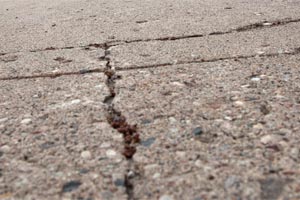There’s an old saying among concrete workers: “There are two kinds of concrete: concrete that has cracked, and concrete that will crack.” The truth is that every concrete slab will crack at some point in time. It’s the nature of concrete. However, a properly designed and installed concrete slab will crack in a controlled way that makes those cracks almost invisible to the casual observer. At Richfield Concrete, we design and install concrete driveways, sidewalks, steps, patios and garage floors using the very best practices to minimize pavement cracking. Here we provide the information that will help you understand why concrete pavements crack and how to prevent it.

Why Concrete Pavement Cracks
Concrete is made up of an aggregate of sand and gravel, held together with cement. Placed in forms as a semi-liquid material, it cures over time to become a hard, stone-like material. Concrete is very strong under compression loads. What that means is that a typical concrete slab on a well-compacted base will resist more than a two-ton load per square inch resting on it without any damage. Concrete also resists surface damage, due to its hard surface.
On the other hand, concrete has much less strength in tension. That means that forces that tend to pull it apart or bend it can easily cause the bond between the cement and the aggregate to break, creating a crack. The cement that binds the aggregate is relatively brittle. Some of the tension and bending forces that can crack concrete include:
- Movement or Sagging of the Base – If the base material under the concrete swells, moves, or sags, the weight of the concrete itself, along with the weight of object, like cars, on the concrete can create a bending force. This can cause cracks to form.
- Expansion and Contraction – As temperatures change, concrete expands and contracts, like all other substances. In Minnesota, where the range of temperatures is extreme, it can create tension forces that can cause cracks in concrete.
- Hydraulic Pressure – Water that collects under concrete, roots growing under concrete, and the expansion of water when it freezes, can also create bending forces, which can crack concrete. Once a crack develops, too, it allows water infiltration and the freeze/thaw cycle and hydraulic pressure may increase.
- Edge Loads – Heavy weights on the edges of a concrete slab can also cause bending forces that can crack concrete, especially if the base near the edges has been infiltrated with soil.
- Shrinkage During Curing – Excessive water loss during the curing stage of concrete can result in the slab shrinking, which can cause cracks. A curing agent applied to the concrete after finishing helps to minimize this.
Minimize Concrete Pavement Cracking
There are a number of ways that a concrete contractor can help to control cracking. Most of these have to do with the original installation of the concrete. Some of these crack control method include:
- Proper Base Preparation – Creating a proper base for the concrete is essential. The base must drain water well to avoid hydraulic forces and freezing and it must be well compacted to prevent settling. Richfield Concrete knows the soil types in the Twin Cities area intimately, and will recommend the proper base for your particular project.
- Control Joints – After a slab is poured, control joints are created in it, either by hand tooling or sawing. Another method, for smaller slabs, uses Zip Strips, which create the joints when removed. What control joints do is to create a weak spot in the slab, so that when it cracks it will crack at the control joint. Such cracks are straight and almost invisible.
- Reinforcement – Reinforcement, using a grid of steel rebar or steel reinforcing fabric adds considerable tensile strength to the slab and helps prevent cracking. Additionally, the steel reinforcement helps keep the slab aligned vertically when cracks develop. Additionally, microfiber reinforcement fibers, mixed into the concrete, also add tensile strength and crack resistance. Richfield Concrete will recommend the appropriate reinforcements and includes microfiber reinforcement in all driveway projects.
- Owner Care – Owners can reduce cracking by avoiding heavy loads near the edge of the slab and by controlling drainage to keep water from infiltrating the base at the edges of the slab.
Richfield Concrete – Concrete Cracking Control by Design
Minimizing the effects of the cracking that is inevitable in all concrete begins with the design and construction process of every concrete project. At Richfield Concrete, our long experience and knowledge of soil and weather conditions in Minnesota gives us an edge on designing and installing concrete projects that will resist cracking. In your free, no-obligation consultation with a Richfield Concrete representative, you’ll learn how options you select for your project will work with our expert installation to keep your concrete project looking great for many years to come.




